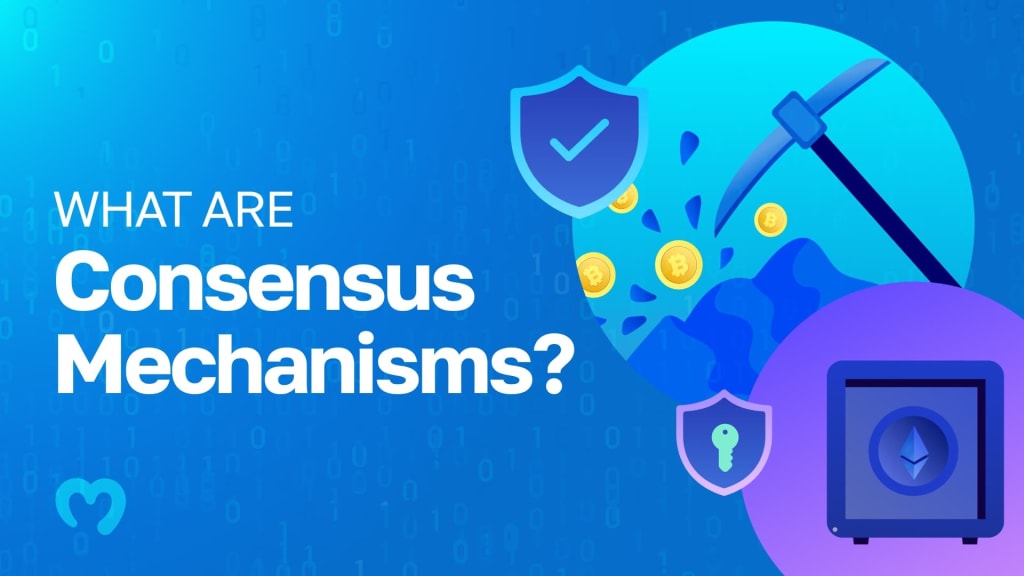Consensus Mechanisms In Blockchain Technology
Consensus Mechanisms

What are Consensus mechanisms?
Consensus mechanisms are an essential part of blockchain technology.
They are the algorithms that allow nodes in a decentralized network to agree on the state of the system without relying on a central authority.
In this article, we will explain in detail the various consensus mechanisms used in blockchain technology.
Introduction to Consensus Mechanisms
A consensus mechanism is a set of rules that ensures that all the nodes in a blockchain network agree on the current state of the network. These mechanisms are designed to prevent malicious actors from altering the state of the network or introducing invalid transactions.
In a decentralized network, there is no central authority to validate transactions or maintain the state of the system. Instead, all the nodes in the network work together to validate transactions and maintain the state of the system. This makes consensus mechanisms an essential part of blockchain technology.
There are several consensus mechanisms used in blockchain technology, and each has its strengths and weaknesses. In this article, we will discuss the most popular consensus mechanisms in detail.
Proof of Work (PoW)
Proof of Work (PoW) is the consensus mechanism used in the Bitcoin network. In PoW, miners compete to solve a complex mathematical puzzle, and the first miner to solve the puzzle gets to add the next block to the blockchain. The mathematical puzzle is designed to be difficult to solve but easy to verify. This ensures that the miner has put in a significant amount of computational effort to solve the puzzle.
Once a miner solves the puzzle and adds the block to the blockchain, the other nodes in the network can easily verify that the solution is correct. This makes it easy for nodes to agree on the state of the network.
The main disadvantage of PoW is that it is energy-intensive. Miners need to use a significant amount of computational power to solve the puzzle, which requires a lot of energy. This has led to concerns about the environmental impact of PoW.
Proof of Stake (PoS)
Proof of Stake (PoS) is a consensus mechanism that is designed to be more energy-efficient than PoW. In PoS, validators are selected based on the amount of cryptocurrency they hold in the network. Validators are then responsible for creating new blocks and validating transactions.
Validators are incentivized to act honestly because they risk losing their stake if they act maliciously. This makes PoS more secure than PoW because validators have a financial stake in the network.
The main disadvantage of PoS is that it is less decentralized than PoW. Validators with a large stake have more influence over the network than smaller validators. This can lead to centralization, which is a concern for some users.
Delegated Proof of Stake (DPoS)
Delegated Proof of Stake (DPoS) is a consensus mechanism that is designed to be even more energy-efficient than PoS. In DPoS, users can vote for delegates who are responsible for creating new blocks and validating transactions.
Delegates are incentivized to act honestly because they risk losing their position if they act maliciously. This makes DPoS more secure than PoS because delegates have a financial stake in the network.
The main disadvantage of DPoS is that it is even less decentralized than PoS. Delegates with a large number of votes have more influence over the network than smaller delegates. This can lead to centralization, which is a concern for some users.
Proof of Authority (PoA)
Proof of Authority (PoA) is a consensus mechanism that is designed to be even more centralized than DPoS. In PoA, a group of trusted validators are responsible for creating new blocks and validating transactions.
Validators are chosen based on their reputation, and they are incentivized to act honestly because their reputation is at stake. This makes PoA more secure than PoW, PoS, or DPoS.
Proof of Elapsed Time (PoET)
Proof of Elapsed Time (PoET) is a consensus mechanism developed by Intel. It is based on a lottery system, where nodes compete for the right to validate transactions and add new blocks to the blockchain.
The lottery is based on a random waiting time, and the node with the shortest waiting time is chosen as the winner. The waiting time is determined by a trusted execution environment, which ensures fairness and prevents nodes from cheating. PoET is energy-efficient, fast, and scalable, but it requires a trusted execution environment, which can be a central point of failure.
Byzantine Fault Tolerance (BFT)
Byzantine Fault Tolerance (BFT) is a consensus mechanism designed to achieve consensus in distributed systems where nodes may fail or behave maliciously. It is based on a voting system, where nodes vote on the validity of transactions and blocks.
BFT can tolerate a certain number of faulty nodes or malicious actors without compromising the security and consistency of the system.





Comments
There are no comments for this story
Be the first to respond and start the conversation.